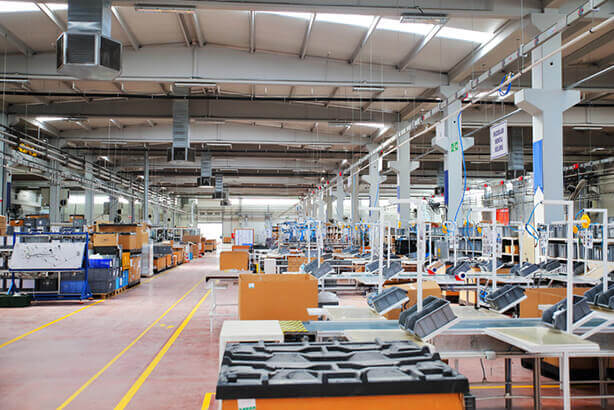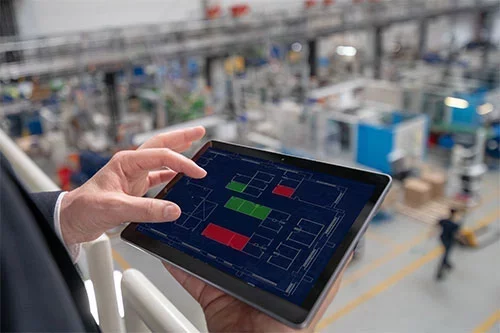Contents
What is an indoor positioning system and how does it work? To see which indoor location tracking is right for you, check our article. Here is what we will cover in this article:
Indoor location tracking services create new opportunities for businesses looking to make faster and better decisions based on real-time data. With modern indoor tracking systems businesses can increase the productivity and safety of their workers, equipment, and work sites by:
- Ensuring assets are not lost or misplaced
- Faster asset retrieval times
- Improved capacity utilization
- Better worksite workflows and utilization
- More efficient responses to workplace emergencies and/or evacuations
- Less workplace injuries and accidents
- Ability to focus more on value added activities
- Less workflow interruptions through contract tracing
Indoor positioning systems are particularly useful for lone workers, roll-call, pandemic workplace practices, warehousing, logistics, and forklift operations.
What is an indoor positioning system?
Indoor positioning systems consist of a network of connected devices working together to provide location tracking services for people and assets unable to be tracked with traditional technologies such as GPS or satellite.
GPS and satellite systems for indoor positioning systems are limited by their lack of precision and/or lack of ability for their signals to reach their desired location.
In situations where GPS and satellite positioning systems will fail or not provide precise enough data, businesses will turn to indoor positioning systems to gain functional insights into the movement of people and assets within the workplace.
Examples where indoor positioning systems are useful include: airports, underground locations, remote workplaces, mining operations, and multistory buildings.
Real Time Location Systems
Real time location systems (RTLS) are indoor tracking systems capable of location and monitoring people and company assets operating within a defined zone covered by a radio frequency (RF) network. They work through a connected network of RF receivers and active RFID transmitters to provide precise and accurate indoor tracking services for each staff member, piece of equipment, and vehicle.
What is indoor location tracking?
Indoor location tracking is similar to GPS location services but is designed specifically for indoor environments where satellite signals cannot reach. It allows users to determine the location of people, equipment, and assets within a building by using smartphones, tracking tags, mobile devices, or sensors that support indoor location tracking and indoor positioning tracking services. These systems are crucial for industries such as manufacturing, healthcare, logistics, and retail, enabling real-time visibility that helps teams make informed decisions, ensure safety, and enhance productivity.
The capabilities of indoor positioning tracking vary depending on the technology used to generate and receive location data. Common options include Wi-Fi, Bluetooth Low Energy (BLE), Ultra-Wideband (UWB), RFID, and infrared systems, each offering different levels of precision, scalability, and cost efficiency. There are five distinct categories to consider when choosing which indoor location tracking system best fits your operational needs: accuracy, coverage, latency, scalability, and integration capabilities. By carefully evaluating these aspects, organizations can select a solution that delivers both high performance and long-term value, supporting smarter, safer, and more efficient indoor environments.
What are types of indoor location tracking technology?
Many technologies are used for indoor tracking ranging from multi-purpose devices, such as cell phones, Wi-Fi and Bluetooth antennas, clocks, and digital cameras. Other indoor tracking is done through relays and beacons of location information using lights, radio waves, magnetic fields, behavioural analytics, acoustic signals, and/or ultra wide-band frequencies.
Each technology used for indoor tracking systems has pros and cons in terms of cost, practicality, flexibility, interference with other systems, ease of use, maintenance, precision, and accuracy.
What are the components of an indoor positioning system?
Indoor positioning systems (IPS) mostly operate using the same methods of producing and receiving different kinds of signals to determine the location of people and objects.
The term mostly used for devices capable of receiving location information are called anchors, and the devices generating location data for people or objects are called location tags.
Each system contains components unique for its style of location tracking, and possess varying degrees of accuracy, cost, and feasibility under certain conditions.
How does indoor positioning system work?
Indoor location tracking revolves primarily around 5 distinct types of tracking:
Wi-Fi based indoor positioning systems
Wi-Fi based indoor tracking systems work through Wi-Fi transmission tags sending small packets of information to Wi-Fi access points throughout the workplace. Each Wi-Fi access point uses information received from the Wi-Fi transmission tags to compute the position of the tags with between 3-5 meters of accuracy. Wi-Fi based indoor tracking systems may be expensive to implement within companies without Wi-Fi access points to support location tracking.
Acoustic systems
Acoustic systems work in a similar way to ultra wide-band (UWB) systems, but use sound waves instead of radio frequencies. They use a network of receivers and transmitters to send and receive ultrasonic sounds (sound you cannot hear) for location tracking. The most accurate acoustic systems are sonar-based systems which can almost be as accurate as UWB systems, however, they can be expensive to use and are mostly used for niche cases within the healthcare industry.
Infrared systems
Light pulses are used in infrared systems similar to how TV remotes work. Each indoor area will have infrared (IR) receivers for communicating with IR tags. IR systems are highly accurate within indoor rooms, but cannot provide location tracking services that penetrate through walls. IR systems are best suited for locations with many individual rooms and clearly separated areas, and are least well suited for warehouses and manufacturing facilities.
Proximity-based systems
Indoor positioning using proximity systems gives a general location of the object of interest, such as a person or object within a room. They do not provide highly precise locations like UWB systems.
Proximity-based systems work through either a reader-based or reference point-based system. Reader-based systems work through tags, continuously transmitting their identity to reader devices that can calculate the position of each tag. Reference point-based systems work using bluetooth low energy (BLE) to communicate between BLE beacons and specific reference points within an area to determine an object position.
Both types of proximity-based systems are the cheapest system to implement for indoor position tracking and are commonly used in both healthcare and manufacturing settings. However they do not provide the level of accuracy, precision, and intelligence of UWB systems.
Ultra wide-band systems
Ultra wide-band (UWB) systems are the most accurate and precise technology in use today for indoor location tracking.
They consist of UWB tags, anchor points, and a gateway to local servers and cloud servers to display location information. UWB tags generate pulses over a wide GHz spectrum to anchor points which are able to produce highly accurate location data based on the timing of receiving pulses from UWB tags.
UWB systems are primarily used for inventory management, material/equipment management within manufacturing facilities, and for workplace safety applications in a wide variety of industries. Since UWB systems can function over a wide GHz spectrum they do not interfere with other communication systems operating in the same environment like proximity and Wi-Fi based location tracking systems do.
Which industries can use indoor positioning systems?
Indoor positioning systems are used in many industries to increase the efficiency of tracking assets, employees, forklifts, maintenance, processes, and RTLS yard management, while also improving safety related to lone workers, roll-call, pandemic workplace practices, and forklift operations.
Industries that can benefit from the indoor positioning systems are:

Location tracking systems within manufacturing rtls environments are implemented to improve occupational safety and optimize the utilization of equipment and workers. They provide data-driven insights in real-time to mitigate risks in the manufacturing facility for employees and managers related to safety and efficiency.
The healthcare industry uses indoor positioning systems to secure their assets and provide continuous patient status updates regarding inactivity, falls, wandering, abduction, and duress alerts. They are also used to monitor the flow of patients, monitor their care, manage logistics (transportation of equipment, samples, visitors, suppliers, and patients), staff workloads, and claim mitigation for accidents, staff/patient interactions, and geofencing violations. Specifically indoor positioning systems are useful for applications related to safety for senior living, infant tracking and safety, patient flow and safety, hospital staff tracking, and EMS inventory tracking.
Indoor positioning systems work well for both underground and above-ground construction sites. They can be used to create detailed reports of asset usage and movement within the construction site during working hours. In the case of workplace accidents and/or injuries, these reports serve as evidence in the case of any claims.


The mining, oil & gas industries are required to follow strict safety regulations while maintaining compliance with industrial requirements. Indoor positioning systems allow managers in these industries to gain meaningful insight based on location data about their equipment and workers by monitoring the flow of materials, cycle times, trips, and other key statistics.
The aviation industry requires tracking for both indoor and outdoor environments with a lot of moving parts moving between indoors and outdoors. Indoor tracking systems in the aviation industry center around creating a connected network of vehicles, ground support equipment (GSE), and staff to coordinate airport services. The goal of these systems is to increase the efficiency of ground handling and maintenance operations to ensure on-time departures and arrivals. Indoor positioning systems can track line maintenance teams, parts, tools, and kits to improve the productivity of the entire airport.
Indoor Positioning Tracking: Boost Visibility and Control
In environments where GPS-based systems fall short, indoor positioning tracking steps in to fill the gap, enabling businesses to monitor people, vehicles, and assets with precision. With this technology, you gain actionable visibility on asset flows, worker movements, and process bottlenecks, helping to reduce loss, improve workflow, and respond swiftly in emergencies.
When integrated into broader operational systems, indoor positioning tracking becomes a strategic lever: machine operators, inventory, and infrastructure are synchronised in real-time, giving teams the agility to optimise resource use and enhance safety. Implementing this system means moving beyond mere location data to achieving full situational awareness across your facility.
Conclusion
Indoor positioning and types of indoor location tracking are done using several different methods, each varying in efficiency and cost depending on the location tracking requirements.
Thankfully, new developments in technology, and the scale of production of these technologies, are making highly accurate indoor location tracking more useful and affordable; especially for ultra wide-band (UWB) systems.






